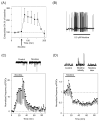Regulation of synaptic transmission and plasticity by neuronal nicotinic acetylcholine receptors
- PMID: 17689497
- PMCID: PMC2047292
- DOI: 10.1016/j.bcp.2007.07.001
Regulation of synaptic transmission and plasticity by neuronal nicotinic acetylcholine receptors
Abstract
Nicotinic acetylcholine receptors (nAChRs) are widely expressed throughout the central nervous system and participate in a variety of physiological functions. Recent advances have revealed roles of nAChRs in the regulation of synaptic transmission and synaptic plasticity, particularly in the hippocampus and midbrain dopamine centers. In general, activation of nAChRs causes membrane depolarization and directly and indirectly increases the intracellular calcium concentration. Thus, when nAChRs are expressed on presynaptic membranes their activation generally increases the probability of neurotransmitter release. When expressed on postsynaptic membranes, nAChR-initiated calcium signals and depolarization activate intracellular signaling mechanisms and gene transcription. Together, the presynaptic and postsynaptic effects of nAChRs generate and facilitate the induction of long-term changes in synaptic transmission. The direction of hippocampal nAChR-mediated synaptic plasticity - either potentiation or depression - depends on the timing of nAChR activation relative to coincident presynaptic and postsynaptic electrical activity, and also depends on the location of cholinergic stimulation within the local network. Therapeutic activation of nAChRs may prove efficacious in the treatment of neuropathologies where synaptic transmission is compromised, as in Alzheimer's or Parkinson's disease.
Figures




Similar articles
-
Nicotinic acetylcholine receptors at glutamate synapses facilitate long-term depression or potentiation.J Neurosci. 2005 Jun 29;25(26):6084-91. doi: 10.1523/JNEUROSCI.0542-05.2005. J Neurosci. 2005. PMID: 15987938 Free PMC article.
-
α6-Containing nicotinic acetylcholine receptors in midbrain dopamine neurons are poised to govern dopamine-mediated behaviors and synaptic plasticity.Neuroscience. 2015 Sep 24;304:161-75. doi: 10.1016/j.neuroscience.2015.07.052. Epub 2015 Jul 23. Neuroscience. 2015. PMID: 26210579 Free PMC article.
-
Modulatory role of presynaptic nicotinic receptors in synaptic and non-synaptic chemical communication in the central nervous system.Brain Res Brain Res Rev. 1999 Nov;30(3):219-35. doi: 10.1016/s0165-0173(99)00016-8. Brain Res Brain Res Rev. 1999. PMID: 10567725 Review.
-
Muscle Nicotinic Acetylcholine Receptors May Mediate Trans-Synaptic Signaling at the Mouse Neuromuscular Junction.J Neurosci. 2018 Feb 14;38(7):1725-1736. doi: 10.1523/JNEUROSCI.1789-17.2018. Epub 2018 Jan 11. J Neurosci. 2018. PMID: 29326174 Free PMC article.
-
Nicotinic mechanisms influencing synaptic plasticity in the hippocampus.Acta Pharmacol Sin. 2009 Jun;30(6):752-60. doi: 10.1038/aps.2009.39. Epub 2009 May 11. Acta Pharmacol Sin. 2009. PMID: 19434057 Free PMC article. Review.
Cited by
-
Nicotinic Acetylcholine Receptor Agonists for the Treatment of Alzheimer's Dementia: An Update.Nicotine Tob Res. 2019 Feb 18;21(3):370-376. doi: 10.1093/ntr/nty116. Nicotine Tob Res. 2019. PMID: 30137524 Free PMC article. Review.
-
Significant modulation of mitochondrial electron transport system by nicotine in various rat brain regions.Mitochondrion. 2009 Jun;9(3):186-95. doi: 10.1016/j.mito.2009.01.008. Epub 2009 Jan 30. Mitochondrion. 2009. PMID: 19460297 Free PMC article.
-
Beneficial effects of nicotine, cotinine and its metabolites as potential agents for Parkinson's disease.Front Aging Neurosci. 2015 Jan 9;6:340. doi: 10.3389/fnagi.2014.00340. eCollection 2014. Front Aging Neurosci. 2015. PMID: 25620929 Free PMC article. Review.
-
Nicotinic receptors, amyloid-beta, and synaptic failure in Alzheimer's disease.J Mol Neurosci. 2010 Jan;40(1-2):221-9. doi: 10.1007/s12031-009-9237-0. Epub 2009 Aug 19. J Mol Neurosci. 2010. PMID: 19690986 Review.
-
Nicotinic receptor-evoked hippocampal norepinephrine release is highly sensitive to inhibition by isoflurane.Br J Anaesth. 2009 Mar;102(3):355-60. doi: 10.1093/bja/aen387. Epub 2009 Feb 2. Br J Anaesth. 2009. PMID: 19189985 Free PMC article.
References
-
- Lein ES, Hawrylycz MJ, Ao N, Ayres M, Bensinger A, Bernard A, et al. Genome-wide atlas of gene expression in the adult mouse brain. Nature. 2007;445:168–76. - PubMed
-
- Unwin N. Acetylcholine receptor channel imaged in the open state. Nature. 1995;373:37–43. - PubMed
-
- Cooper E, Couturier S, Ballivet M. Pentameric structure and subunit stoichiometry of a neuronal nicotinic acetylcholine receptor. Nature. 1991;350:235–8. - PubMed
-
- Lindstrom JM. Acetylcholine receptors and myasthenia. Muscle Nerve. 2000;23:453–77. - PubMed
-
- Miyazawa A, Fujiyoshi Y, Unwin N. Structure and gating mechanism of the acetylcholine receptor pore. Nature. 2003;423:949–55. - PubMed
Publication types
MeSH terms
Substances
Grants and funding
LinkOut - more resources
Full Text Sources
Other Literature Sources

